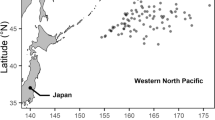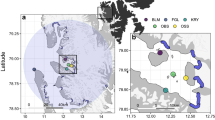Synopsis
We report the first investigation of the structure of schools of predatory fish, analyzed from aerial photographs of Atlantic bluefin tuna,Thynnus thynnus, in the wild. Internal structure of formations of giant bluefin supports two hypotheses for the formation of predatory fish schools. The parabolic shape of the schools suggests that tuna hunt cooperatively and the position of fish within the schools is such that individuals benefit from hydrodynamical interactions with their neighbors.
Similar content being viewed by others
References cited
Batschelet, E. 1965. Statistical methods for the analysis of problems in animal orientation and certain biological rhythms. A.I.B.S. monograph. 57 pp.
Brock, V.E. & R.H. Riffenburgh. 1960. Fish schooling: a possible factor in reducing predation. J. cons. perm. Int. Explor. Mer. 25: 307–317.
Cullen, J. M., E. Shaw & H. Baldwin. 1965. Methods for measuring the 3-D structure of fish schools. Anim. Behav. 13: 534–543.
Cushing, D.H. & F.R. Harden-Jones. 1968. Why do fish school? Nature 218: 918–920.
Dill, L.M., R.L. Dunback & P.F. Major. 1981. A new stereophotographic technique for analyzing 3-D structure of fish schools. Env. Biol. Fish. 6: 7–13.
Eggers, D.M. 1976. Theoretical effect of schooling by planktivorous fish predators on rate of prey consumption. J. Fish. Res. Board Can. 33: 1964–1971.
Hiatt, R.W. & V.E. Brock. 1948. On the herding of prey and schooling of the black skipjack. Pacific Sci. 2: 297–298.
Hunter, J.R. 1969. Communication of velocity changes in jack mackerelTrachurus symmetricus schools. Anim. Behav. 17: 507–514.
Hurley, A.C. 1978. School structure of the squid (Loligo opalescens). U. S. Fish. Bull. 70: 433–442.
Katz, L., M.J. Potel & R. Wassersug. 1981. Structure and mechanisms of schooling inXenopus laeris larvae (Amphibia: anura). Anim. Behav. 29: 20–34.
Lissaman, P.S.S. & C.A. Schollenberger. 1970. Formation flight of birds. Science 168: 1003–1005.
Major, P.F. 1978. Predator-prey interactions in two schooling fishes,Caranx ignoblis andStolephorus purpureus. Anim. Behav. 26: 760–778.
Olson, F.C.W. 1964. The survival value of fish schooling. J. cons. perm. Int. Explor. Mer. 29: 115–116.
Olst van, J.C. & J.R. Hunter. 1970. Some aspects of the organization of fish schools. J. Fish. Res. Board Can. 27: 1225–1238.
Partridge, B.L. 1981a. Lateral line function and schooling. pp. 512–522.In: R.R. Fay, A.N. Popper & W.N. Tavolga (ed.) Hearing and Sound Communication in Fishes, Springer-Verlag, New York.
Partridge, B.L. 1981b. Internal dynamics and the interrelations of fish in schools. J. Comp. Physiol. 144: 313–325.
Partridge, B.L. 1982a. Rigid definitions of fish schools are inadequate. Anim. Behav. 30: 298–299.
Partridge, B.L. 1982b. Structure and function of fish schools. Sci. Amer. 245: 114–123.
Partridge, B.L. & J.M. Cullen. 1978. A low-cost interactive coordinate plotter. Behav. Res. Meth. Instr. 9: 473–479.
Partridge, B.L. & T.J. Pitcher. 1979. Evidence against a hydrodynamic function of fish schools. Nature 279: 418–419.
Partridge, B.L. & T.J. Pitcher. 1980. The sensory basis of fish schools: relative roles of lateral line and vision. J. Comp. Physiol. 135: 315–325.
Partridge, B. L., Pitcher, T.J., J.M. Cullen & J. Wilson. 1980. The three dimensional structure of schools of saithe, cod and herring. Behav. Ecol. Sociobiol. 6: 277–288.
Pitcher, T.J. & B.L. Partridge. 1979. Fish school density and volume. Marine Biology 54: 383–394.
Shaw, E. 1970. Schooling in fishes: critique and review. pp. 452–480. In: Aronson et al. (ed.) Development and Evolution of Behaviour, W.H. Freeman, San Francisco.
Shaw, E. 1978. Schooling fishes. Amer. Sci. 66: 166–175.
Treisman, M. 1976. Predation and the evolution of gregariousness. I. Models of concealment and evasion. Anim. Behav. 23: 779–800.
Wassersug, R.J., A.M. Lum & M.J. Potel. 1981. An analysis of school structure for tadpoles (Anura: Amphibia). Behav. Ecol. Sociobiol. 9: 15–22.
Weihs, D. 1973. Hydrodynamics of fish schooling. Nature 241: 290–291.
Weihs, D. 1975. Same hydrodynamical aspects of fish schooling. pp. 703–718.In: T. Wu et al. (ed.) Swimming and Flying in Nature, Pasadena.
Williams, G.C. 1964. Measurements of consociation among fishes and comments on the evolution of schooling. Pub. Mus. Mich. State Univ. Ser. 2: 349–384.
Author information
Authors and Affiliations
Rights and permissions
About this article
Cite this article
Partridge, B.L., Johansson, J. & Kalish, J. The structure of schools of giant bluefin tuna in Cape Cod Bay. Environ Biol Fish 9, 253–262 (1983). https://doi.org/10.1007/BF00692374
Issue Date:
DOI: https://doi.org/10.1007/BF00692374




